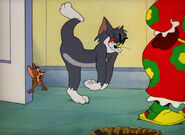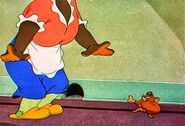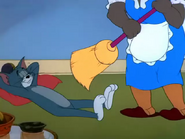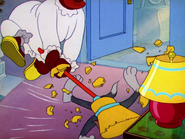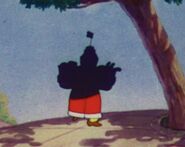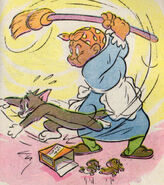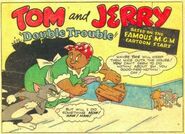No edit summary Tag: Visual edit |
(→Trivia) Tag: Visual edit |
||
| (118 intermediate revisions by 53 users not shown) | |||
| Line 1: | Line 1: | ||
{{Character |
{{Character |
||
| − | |image = |
+ | |image = Mammytwoshoes-1-.jpg |
| − | |species = Human |
||
| ⚫ | |||
| − | |voiced by = [[wikipedia:Lillian Randolph|Lillian Randolph]] (original)<br>[[Wikipedia:Thea Vidale|Thea Vidale]] (dubbed versions)<br>[[wikipedia:Nicole Oliver|Nicole Oliver]] (Tom and Jerry Tales) |
||
| ⚫ | |||
| − | |enemies = [[Jerry Mouse|Jerry]], [[Tom Cat|Tom]] (sometimes), [[Butch]] (sometimes), [[Lightning Cat|Lightning]] (in the end), [[Topsy Cat|Topsy]] (in the end) |
||
| ⚫ | |||
| − | |skin colour = Black |
||
| − | |loses = None |
||
| − | |debut appearance = [[Puss Gets the Boot]]|Sex = Female|First appearance = [[Puss Gets the Boot]]}}'''Mammy Two Shoes''' (also known as '''Mammy''', '''Mammy Two-Shoes''', '''Mrs. Two Shoes''' in ''[[Tom and Jerry Tales]]'' or '''Dinah''' in the 1940 Tom and Jerry comics), is a recurring character in MGM's ''Tom and Jerry'' cartoons. She is a heavy-set, middle-aged African-American woman who often has to deal with the mayhem generated by the lead characters, but whether she is the owner of the home or merely the house-keeper is never really made clear. |
||
| ⚫ | |||
| − | As a partially-seen character, she was famous for never showing her head and face (although it is briefly visible in [[Saturday Evening Puss]] and [[Part Time Pal]]). Mammy's appearances have often been edited out, dubbed, or re-animated as a slim white woman in later television showings, since her character is a mammy archetype now often regarded as racist. It was later revealed that her character was greatly inspired by Oscar-winning African-American actress and singer Hattie McDaniel, best known for playing "Mammy" in MGM and David O. Selznick's 1939 film. |
||
| + | |aka = Dinah (1940s ''Tom and Jerry'' comics)<br>Cook (''Tom and Jerry'' books) |
||
| ⚫ | |||
| ⚫ | |||
| + | |enemies = Jerry Mouse<br>Tom Cat (sometimes)<br>Butch Cat<br>Lightning Cat<br>[[Topsy Cat]]<br>[[Spike Bulldog]] |
||
| + | |voiced_by=[[wikipedia:Lillian Randolph|Lillian Randolph]] (original)<br>Anita Brown ([[The Mouse Comes to Dinner]])<br>[[Wikipedia:Thea Vidale|Thea Vidale]] (dubbed versions) |
||
| + | |first_appearance = ''[[Puss Gets the Boot]]'' |
||
| ⚫ | |||
| + | }} |
||
| + | '''Mammy Two Shoes''' (also known as '''Mammy''', '''Mammy Two-Shoes''', or '''Dinah''' in the 1940s ''[[Tom and Jerry]]'' comics) is a recurring character who appeared in 19 of MGM's ''Tom and Jerry'' cartoons. |
||
| − | A character very similar to Mammy Two Shoes had earlier been portrayed in the Disney'' Silly Symphonies'' shorts ''Three Orphan Kittens'' and ''More Kittens'', as well as the Pluto short Pantry Pirate and the Figaro short ''Figaro and Cleo''. A similar character ''Petunia the Mammy'' actually shows her face which (of course) resembles blackface in the ''Little Audrey'' cartoon series. |
||
| + | She is a heavy-set, middle-aged African-American woman who often has to deal with the mayhem generated by the lead characters, but whether she is the owner of the home or merely the house-keeper is never really made clear. She is based on the "Mammy" archetype that was prevalent throughout the U.S. in the 19th and early 20th century. |
||
| + | As a [[wikipedia:Unseen_character|partially-seen character]], she was famous for never showing her head and face (although it is briefly visible in ''[[Part Time Pal]]'', ''[[A Mouse in the House]]'', ''[[Mouse Cleaning]]'', and ''[[Saturday Evening Puss]]''). |
||
| ⚫ | |||
| ⚫ | With dark brown skin (later changed to an ivory-colored skin tone) she is distinguished by her usual, sleeveless dress with frills in the shoulders, a white apron with frills in the trim, old, yellow socks (often seen with some kind of suspender holding it up) and red slippers. The color of her attire often changes, but the pieces remain virtually the same. These colors are yellow, orange, green, blue, and red. She is usually seen holding a broom. |
||
| + | Due to the modern-day controversy of the archetype, beginning in the 1960s, the Mammy character has been dubbed, censored, re-animated, or edited out in television broadcasts. |
||
| ⚫ | |||
| − | ==Theatrical ''Tom and Jerry'' cartoons== |
||
| ⚫ | |||
| + | == History == |
||
| − | Mammy first appeared in [[Puss Gets the Boot]], the first Tom and Jerry cartoon (except Tom was called "Jasper"). She always referred to Tom as his given name Thomas and almost always used "is" in conjunction with a pronoun ("is you" and "I is"). The character went on to make many appearances through 1952's [[Push-Button Kitty]]. William Hanna and Joseph Barbera initially portrayed Mammy as the maid of the house, with the real owners unknown to us. Later, Hanna and Barbera seemed to suggest, through dialogue and occasional behavior, that the house was Mammy's own. |
||
| + | Mammy's debut appearance was in ''[[Puss Gets the Boot]]'', while her last appearance was in ''[[Push-Button Kitty]]''. She was originally voiced by well-known African-American character actress Lillian Randolph. She was the second prominent black character of the [[Metro-Goldwyn-Mayer cartoon studio]], following Bosko. She appeared in 19 ''[[Tom and Jerry]]'' animated shorts between 1940 and 1952. |
||
| ⚫ | |||
| − | Mammy was originally voiced by well-known African-American voice actress Lillian Randolph. In the 1960s, the MGM animation cartoon, by then under the supervision of Chuck Jones, created censored versions of the ''Tom & Jerry'' cartoons featuring Mammy for television. These versions used rotoscoping techniques to replace Mammy on-screen with a thin white woman, and the voice on the soundtracks was replaced by an Irish-accented voice performed by white actress June Foray. The original versions of the cartoons were reinstated when Turner Broadcasting acquired ownership of the ''Tom & Jerry'' property. But in 1992, the cartoons featuring Mammy were edited again; this time, to replace Lillian Randolph's voice with that of Thea Vidale, whose dialogue was redone to remove the Mammy character's use of potentially offensive dialect. These versions of the cartoons are aired to this day on Turner's Cartoon Network-related cable channels, and have turned up on DVD as well. However, some European TV showings of these cartoons, especially the UK, retain Randolph's original voice. The Region 2 ''Complete Collectors Edition'' DVD box set has Vidale's voice on the first DVD and Randolph in a number of the episodes after that (such as ''A Mouse in the House'' and ''Mouse Cleaning''). This continued to this day after the death of Lillian Randolph in 1980. |
||
| + | One of Mammy's roles in the films was to set up the plot by warning [[Tom Cat|Tom]] that she will toss him out of the house if he failed to act according to her wishes. She invariably catches Tom acting against her orders, and there are grave consequences. Naturally, it is [[Jerry Mouse|Jerry]] that sabotages Tom to get him in trouble. She always called Tom by his full name ''Thomas'' (originally ''Jasper''), and almost always used ''is'' in place of ''are'' and ''am'' ("is you" and "I is"). Her signature quotes are "Land Sakes!" and "What in the world is going on in here?", the latter of which is usually delivered upon rushing in to investigate the commotion being caused by Tom and Jerry. |
||
| + | William Hanna and Joseph Barbera initially portrayed Mammy as the maid of the house, with the real owners unknown to audiences - at least, her apron suggests she is a maid. Later, Hanna and Barbera seemed to suggest, through dialogue and occasional behavior, that the house was Mammy's own. On one occasion, she goes to her bedroom. This suggests she owns the house and is its sole human occupant, though the cutting continuity filed with each short at the Library of Congress always referred to the character as "Maid." |
||
| − | In "Power Gal" she wears a Power Gal uniform. |
||
| + | Mammy Two-Shoes was retired from the Tom & Jerry cartoons by Hanna and Barbera following several years of protests and condemnations from the NAACP. A 1949 reissue of the 1943 short ''[[The Lonesome Mouse]]'' prompted the start of the NAACP's campaign against ''Tom & Jerry''. In this short, Mammy is scared by Jerry onto a stool and shaken as a straight razor, dice, and other stereotypical props fall from beneath her dress. When Randolph departed from ''Tom & Jerry'' to appear on television, Hanna and Barbera declined to recast the voice role and Mammy ceased to appear in the cartoons. |
||
| − | ==Replacement characters for Mammy== |
||
| ⚫ | |||
| − | From 1954's ''[[Pet Peeve]]'', Mammy disappeared from ''Tom and Jerry''; the owners of the animals' house became a young, white, middle-class couple named Joan and George, and starting with 1955's ''[http://en.wikipedia.org/wiki/The_Flying_Sorceress The Flying Sorceress]'', the audience was able to see these owners' heads. |
||
| + | === Censorship, discontinuation, and callbacks === |
||
| − | In 1961, when [http://en.wikipedia.org/wiki/William_L._Snyder Rembrandt Films] began producing ''Tom and Jerry'' shorts, the owner of the house became a corpulent white man. The character was designed by [http://en.wikipedia.org/wiki/Gene_Deitch Gene Deitch], who recycled the design from his [http://en.wikipedia.org/wiki/Terrytoons Terrytoons] character Clint Clobber.<sup class="reference" id="cite_ref-1">[http://en.wikipedia.org/wiki/Mammy_Two_Shoes#cite_note-1 [2]]</sup> This new owner, whose face would turn bright red, and often derived great glee in doing so, was more graphically brutal in punishing Tom's mistakes as compared to Mammy Two Shoes, such as beating and thrashing Tom repeatedly, searing his face with a grill and forcing Tom to drink an entire carbonated beverage. "Clobber" (for want of a better name) was introduced in ''[http://en.wikipedia.org/wiki/Down_and_Outing Down and Outing]'' as a [http://en.wikipedia.org/wiki/Fisherman fisherman] who owned Tom as well as their house. "Clobber" later appeared in ''[http://en.wikipedia.org/wiki/High_Steaks High Steaks]'' as a [http://en.wikipedia.org/wiki/Chef chef], and ''[http://en.wikipedia.org/wiki/Sorry_Safari Sorry Safari]'' as a [http://en.wikipedia.org/wiki/Hunter hunter] before being dropped. |
||
| + | Director [[Gene Deitch]] stated that the "retiring" of Mammy's character was one of the changes that he felt he needed to make for the 13 shorts produced by [[Rembrandt Films]].<ref>[https://cartoonresearch.com/index.php/tom-jerry-the-gene-deitch-collection/ "''Tom & Jerry'' – The Gene Deitch Collection" (Paragraph 7) - Gene Deitch (cartoonresearch.com)]</ref> |
||
| + | [[MGM Animation/Visual Arts]], under the supervision of [[Chuck Jones]], created replacement characters for Mammy in the ''Tom and Jerry'' cartoons featuring her for television. These versions used rotoscoping techniques to replace Mammy on-screen with either a stocky white woman (in most shorts) or a thin white woman (in ''Saturday Evening Puss''); Randolph's voice on the soundtracks was replaced by an Irish-accented (or generic young adult in ''Puss'') voice performed by June Foray.<ref>[http://mammytwoshoes.tripod.com/history.html A History of Mammy Twoshoes]</ref> |
||
| − | Later, Tom's owner varied, with a housewife similar to the re-edited Mammy appearing in the later Deitch short ''[http://en.wikipedia.org/wiki/Buddies_Thicker_Than_Water Buddies Thicker Than Water]'' and the direct-to-DVD film ''[[Tom and Jerry: The Fast and the Furry]]''. |
||
| + | Three years after [[Turner Entertainment]] acquired ''Tom & Jerry'' from MGM, the cartoons featuring Mammy were re-recorded to remove Mammy Two Shoes' use of potentially offensive dialect. Lillian Randolph's voice was dubbed over by Thea Vidale. The re-recorded versions of the cartoons would air on Turner's [[Cartoon Network]]-related cable channels, and have at times turned up on DVD. However, some European TV showings of these cartoons, especially the UK, as well as the US DVD release of ''[[Tom and Jerry Spotlight Collection]]'', ''[[Warner Bros. Home Entertainment Academy Awards Animation Collection]]'', and ''[[Tom and Jerry: The Deluxe Anniversary Collection]]'' and the US DVD and Blu-ray releases of ''[[Tom and Jerry Golden Collection]]'', retain Randolph's original voice. The Region 2 ''Complete Collectors Edition'' DVD boxset has Vidale's voice on the first DVD and Randolph in a number of the episodes after that (such as ''[[A Mouse in the House]]'' and ''[[Mouse Cleaning]]''). |
||
| − | ==''Tom and Jerry Tales'' and Mammy's modern return== |
||
| − | In the modern ''[http://en.wikipedia.org/wiki/Tom_and_Jerry_Tales Tom and Jerry Tales]'' a redesigned Mammy has appeared, debuting in the short ''[[Ho Ho Horrors]]'' and turning up again later on. Though keeping her buxom, overweight build, tough personality, Southern accent and tendency to call Tom "Thomas," Mammy's skin tone has changed to ivory, presumably to avoid any possible controversy. Several photos on a mantle in ''Ho Ho Horrors'' also imply that Mammy now has a family (a man and a boy, also shown only as legs and partial torsos), though they have yet to appear in actual animation. In the short ''[http://en.wikipedia.org/wiki/Power_Tom Power Tom]'' the story casts Mammy as a female superhero called Power Gal, though it's only for this one cartoon. |
||
| + | As of 2011, most cartoons that featured Mammy-Two Shoes are rarely, if ever, aired on Cartoon Network and Boomerang USA. They are also unavailable on the Boomerang Streaming Service. However, some cartoons such as ''The Lonesome Mouse, A Mouse in the House ''and ''Mouse Cleaning ''were already rarely seen due to scenes that are already controversial. This even affects cartoons such as ''Puss N' Toots, The Little Orphan ''and ''The Mouse Comes to Dinner'', in which Mammy-Two Shoes makes minor appearances. These censorship policies were only prevalent in the United States, and not overseas. |
||
| − | In the new shorts, the now-Caucasian Mammy is explicitly called "Mrs. Two-Shoes". |
||
| + | A white woman named "[[Mrs. Two Shoes]]" appeared in some episodes of ''[[Tom and Jerry Tales]]''. She had most aspects of Mammy Two Shoes' personality, a similar look, and a similar name. |
||
| − | ==Featured shorts== |
||
| − | ===Tom and Jerry=== |
||
| ⚫ | |||
| ⚫ | |||
| − | *[[Fraidy Cat|''Fraidy Cat'']] (cameo) (1942) |
||
| − | *[[Dog Trouble|''Dog Trouble'']] (cameo) (1942) |
||
| − | *[[Puss N' Toots|''Puss N' Toots'']] (cameo) (1942) |
||
| ⚫ | |||
| − | *[[The Mouse Comes to Dinner|''The Mouse Comes to Dinner'']] (cameo) (1945) |
||
| − | *[[Part Time Pal|''Part Time Pal'']] (1947) |
||
| − | *[[A Mouse in the House|''A Mouse in the House'']] (1947) |
||
| ⚫ | |||
| − | *[[Mouse Cleaning|''Mouse Cleaning'']] (1948) |
||
| − | *[[Polka-Dot Puss|''Polka-Dot Puss'']] (1949) (cameo) |
||
| − | *[[The Little Orphan|''The Little Orphan'']] (cameo) (1949) |
||
| ⚫ | |||
| − | *[[The Framed Cat|''The Framed Cat'']] (cameo) (1950) |
||
| − | *[[Casanova Cat|''Casanova Cat'']] (cameo) (1951) |
||
| − | *[[Sleepy-Time Tom|''Sleepy-Time Tom'']] (1951) |
||
| − | *[[Nit-Witty Kitty|''Nit-Witty Kitty'']] (1951) |
||
| − | *[[Triplet Trouble|''Triplet Trouble'']] (1952) |
||
| ⚫ | |||
| + | ==Characteristics== |
||
| − | ===''Tom and Jerry Tales'' (as Mrs. Two Shoes)=== |
||
| + | ===Personality=== |
||
| − | *[[Prehisterics|''Prehisterics'']] |
||
| + | Mammy Two Shoes is very impatient with Tom, and is quick to eject him from the house if he misbehaves (or if she thinks he is, even if Jerry is the one responsible). She is afraid of mice and is thus rarely seen interacting with Jerry. |
||
| − | *''[[Ho Ho Horrors]]'' (cameo) |
||
| + | |||
| − | *[[Tin Cat of Tomorrow|''Tin Cat of Tomorrow'']] |
||
| ⚫ | |||
| − | *[[Power Tom|''Power Tom'']] |
||
| ⚫ | With dark brown skin (later changed to an ivory-colored skin tone) she is distinguished by her usual, sleeveless dress with frills in the shoulders, a white apron with frills in the trim, old, yellow socks (often seen with some kind of suspender holding it up), and red slippers. The color of her attire often changes, but the pieces remain virtually the same. These colors are yellow, orange, green, blue, and red. She is usually seen holding a broom. She also wears a red polka dot bandana on her head. |
||
| − | *[[Cat Show Catastrophe|''Cat Show Catastrophe'']] (cameo) |
||
| + | |||
| − | *[[Adventures in Penguin Sitting|''Adventures in Penguin Sitting'']] |
||
| ⚫ | |||
| − | *[[Invasion of the Body Slammers|''Invasion of the Body Slammers'']] (cameo) |
||
| + | |||
| − | *[[Summer Squashing|''Summer Squashing'']] |
||
| + | ==Appearances== |
||
| − | *[[Little Big Mouse|''Little Big Mouse'']] |
||
| + | {| class="wikitable sortable" |
||
| − | *[[You're Lion|''You're Lion'']] |
||
| + | |- |
||
| ⚫ | |||
| + | ! No. !! Title !! Released |
||
| − | *''[[Game of Mouse & Cat]]'' (final appearance) |
||
| + | |- |
||
| ⚫ | |||
| + | |1 |
||
| ⚫ | |||
| + | |February 10, 1940 |
||
| + | |- |
||
| + | |2 |
||
| ⚫ | |||
| + | |July 19, 1941 |
||
| + | |- |
||
| + | |4 |
||
| ⚫ | |||
| + | |January 17, 1942 |
||
| + | |- |
||
| + | |5 |
||
| + | |''[[Dog Trouble]]'' |
||
| + | |April 18, 1942 |
||
| + | |- |
||
| + | |6 |
||
| + | |''[[Puss N' Toots]]'' |
||
| + | |May 30, 1942 |
||
| + | |- |
||
| + | |10 |
||
| ⚫ | |||
| + | |May 22, 1943 |
||
| + | |- |
||
| + | |18 |
||
| + | |''[[The Mouse Comes to Dinner]]'' |
||
| + | |May 5, 1945 |
||
| + | |- |
||
| + | |28 |
||
| + | |''[[Part Time Pal]]'' |
||
| + | |March 15, 1947 |
||
| + | |- |
||
| + | |32 |
||
| + | |''[[A Mouse in the House]]'' |
||
| + | |August 30, 1947 |
||
| + | |- |
||
| + | |36 |
||
| ⚫ | |||
| + | |September 18, 1948 |
||
| + | |- |
||
| + | |38 |
||
| + | |''[[Mouse Cleaning]]'' |
||
| + | |December 11, 1948 |
||
| + | |- |
||
| + | |39 |
||
| + | |''[[Polka-Dot Puss]]'' |
||
| + | |February 26, 1949 |
||
| + | |- |
||
| + | |40 |
||
| + | |''[[The Little Orphan]]'' |
||
| + | |April 30, 1949 |
||
| + | |- |
||
| + | |48 |
||
| ⚫ | |||
| + | |January 14, 1950 |
||
| + | |- |
||
| + | |53 |
||
| ⚫ | |||
| + | |October 21, 1950 |
||
| + | |- |
||
| + | |58 |
||
| + | |''[[Sleepy-Time Tom]]'' |
||
| + | |May 26, 1951 |
||
| + | |- |
||
| + | |61 |
||
| + | |''[[Nit-Witty Kitty]]'' |
||
| + | |October 6, 1951 |
||
| + | |- |
||
| + | |67 |
||
| + | |''[[Triplet Trouble]]'' |
||
| + | |April 19, 1952 |
||
| + | |- |
||
| + | |70 |
||
| ⚫ | |||
| + | |September 6, 1952<ref>[http://www2.boxoffice.com/the_vault/issue_page?issue_id=1952-10-4&page_no=173#page_start Shorts Chart - BoxOffice (1952)]</ref> |
||
| + | |} |
||
==Major appearances== |
==Major appearances== |
||
| − | *'' |
+ | *''The Lonesome Mouse'' - She's tricked by Tom's and [[Jerry]]'s truce. |
| − | *'' |
+ | *''Part Time Pal'' - She is tormented by a drunk [[Tom]]. |
| − | *'' |
+ | *''Old Rockin' Chair Tom'' - Mammy's longest onscreen appearance. She takes a cat named [[Lightning Cat|Lightning]]. |
| − | *'' |
+ | *''Sleepy-Time Tom'' - She keeps an eye on Tom if he's sleeping on the job. |
| − | *'' |
+ | *''Push-Button Kitty'' - She orders a robocat called [[Mechano]]. |
| − | *''[http://en.wikipedia.org/wiki/Tin_Cat_of_Tomorrow Tin Cat of Tomorrow]'' - She orders a robocat called [[Verminator 7000]]. |
||
| − | *''[http://en.wikipedia.org/wiki/Power_Tom Power Tom]'' - She disguises herself as Power Gal to save Tom and Jerry from [[Butch]], Lightning and Topsy in a robbery. |
||
| + | ==Cameos== |
||
| − | ==Voice actresses of Mammy Two Shoes== |
||
| + | *''Fraidy Cat'' |
||
| − | *[http://en.wikipedia.org/wiki/Lillian_Randolph Lillian Randolph]: 1940 - 1952 |
||
| + | *''Dog Trouble'' |
||
| − | *[http://en.wikipedia.org/wiki/Thea_Vidale Thea Vidale]: (Cartoon Network dubbed versions; uncredited) |
||
| + | *''Puss N' Toots'' |
||
| − | *[http://en.wikipedia.org/wiki/June_Foray June Foray]: Mammy as a thin white young woman, first dubbed versions with a similar white Mammy |
||
| + | *''The Mouse Comes to Dinner'' |
||
| − | *[[Tress MacNeille]]: ''[[Tom and Jerry Tales]]'' |
||
| + | *''The Little Orphan'' |
||
| + | *''The Framed Cat'' |
||
| + | *''[[Casanova Cat]]'' - [[Toodles Galore]]'s housemaid physically resembles her |
||
==Gags== |
==Gags== |
||
*Been constantly afraid of Jerry (or mice in general) and jumping to the nearest high spot such as a chair or the balcony. |
*Been constantly afraid of Jerry (or mice in general) and jumping to the nearest high spot such as a chair or the balcony. |
||
*Pulling up the skirt, often pulling up, comically, many layers of skirts with distinct patterns. |
*Pulling up the skirt, often pulling up, comically, many layers of skirts with distinct patterns. |
||
| − | *Easily losing her temper with Tom's shenanigans. |
+ | *Easily losing her temper with Tom's shenanigans, to the point of addressing him as "Thomas!". |
| ⚫ | |||
| − | *In the Tom and Jerry books, Mammy is often referred to as Cook. |
||
| − | *In the 1940s Tom and Jerry comics, Mammy is usually named Dinah. |
||
| − | *The mammy character in Disney's ''Three Orphan Kittens'' is actually named Mammy Twoshoes (note spelling) in some licensed 1930s-1950s book adaptations. |
||
| − | *She was neither seen nor mentioned in ''[[Tom and Jerry: The Movie]] ''and most other modern ''Tom and Jerry'' media. |
||
| ⚫ | |||
| − | *In "''[[Power Tom]]''", her secret identity is Power Gal. |
||
==Gallery== |
==Gallery== |
||
<gallery> |
<gallery> |
||
| − | Part-time-pal.jpg |
+ | Part-time-pal.jpg|Jerry: Tom wait! |
| + | A0UynrR.jpg|"Thomas! Come in and get this chicken stealing mouse!" |
||
| − | A0UynrR.jpg |
||
| + | Push-Button Kitty - Tom relaxing.PNG|"Sorry to disturb you, Mr. Thomas." |
||
| − | Mammy as Power Gal.jpg |
||
| + | Mammy hits Tom.png|Mammy Two-Shoes' s face partially seen in ''[[Part Time Pal]]''. |
||
| ⚫ | |||
| + | 53EEA78C-DCC6-4F0F-A9D8-6C30D89A8F3D.jpeg|A silhouette of Mammy's head. |
||
| + | 8004859A-681B-41AE-93D3-79C9A62E9DA1.jpeg|Mammy's full appearance featured in a comic book. |
||
| + | 385E3DC1-BDAE-42A2-B47B-8666E765D43C.jpeg|Another ''Tom and Jerry'' comic that reveals Mammy's face. |
||
| + | 607AE46C-663A-4DC7-803F-77C7F475949D.jpeg|Even Another ''Tom and Jerry'' comic that reveals Mammy's face. |
||
</gallery> |
</gallery> |
||
| + | |||
| ⚫ | |||
| + | *Coincidentally, some of the [[disney:The_Disney_Wiki|Disney]] cartoons during the 1930s~1940s featured a [[disney:Mammy_Two_Shoes|nearly identical character who shares the same name]] as Mammy Two Shoes. |
||
| + | *In ''[[Saturday Evening Puss]]'', When Mammy Two Shoes dashes home to punish Tom and his friends for throwing a party, her face is briefly shown once. This is the only instance her face is ever seen. |
||
| + | *Although Mammy Two Shoes face was a mystery in the show, she fully appeared with her face in the comics and storybooks. |
||
| + | *In ''[[The Little Orphan]]'', Mammy is seen bringing a turkey to the table. Because the character retired after the release of ''[[Push-Button Kitty]]'', this part is deleted in its remake ''[[Feedin' the Kiddie]]''. |
||
| + | *Although, Mammy Two Shoes met Jerry, she never met [[Tuffy Mouse|Tuffy]]. |
||
| + | **She only met Tuffy in the comics. |
||
| + | |||
| + | ==See also== |
||
| + | *[[Mrs. Two Shoes]] |
||
| + | |||
| + | ==References== |
||
| + | <references /> |
||
| + | |||
[[Category:Characters]] |
[[Category:Characters]] |
||
[[Category:Humans]] |
[[Category:Humans]] |
||
| ⚫ | |||
[[Category:Females]] |
[[Category:Females]] |
||
[[Category:Tom and Jerry Characters]] |
[[Category:Tom and Jerry Characters]] |
||
[[Category:Minor characters]] |
[[Category:Minor characters]] |
||
[[Category:Babysitters]] |
[[Category:Babysitters]] |
||
| ⚫ | |||
| ⚫ | |||
| ⚫ | |||
[[Category:Controversy]] |
[[Category:Controversy]] |
||
[[Category:Supporting Characters]] |
[[Category:Supporting Characters]] |
||
[[Category:Recurring characters]] |
[[Category:Recurring characters]] |
||
| − | [[Category:Tom and Jerry Tales Characters]] |
||
[[Category:MGM Characters]] |
[[Category:MGM Characters]] |
||
| ⚫ | |||
| ⚫ | |||
| ⚫ | |||
| + | [[Category:1940 Introductions]] |
||
| + | [[Category:African American Women]] |
||
| ⚫ | |||
Latest revision as of 18:57, 11 April 2024
Mammy Two Shoes (also known as Mammy, Mammy Two-Shoes, or Dinah in the 1940s Tom and Jerry comics) is a recurring character who appeared in 19 of MGM's Tom and Jerry cartoons.
She is a heavy-set, middle-aged African-American woman who often has to deal with the mayhem generated by the lead characters, but whether she is the owner of the home or merely the house-keeper is never really made clear. She is based on the "Mammy" archetype that was prevalent throughout the U.S. in the 19th and early 20th century.
As a partially-seen character, she was famous for never showing her head and face (although it is briefly visible in Part Time Pal, A Mouse in the House, Mouse Cleaning, and Saturday Evening Puss).
Due to the modern-day controversy of the archetype, beginning in the 1960s, the Mammy character has been dubbed, censored, re-animated, or edited out in television broadcasts.
History
Mammy's debut appearance was in Puss Gets the Boot, while her last appearance was in Push-Button Kitty. She was originally voiced by well-known African-American character actress Lillian Randolph. She was the second prominent black character of the Metro-Goldwyn-Mayer cartoon studio, following Bosko. She appeared in 19 Tom and Jerry animated shorts between 1940 and 1952.
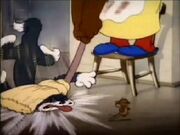
Mammy Two Shoes attacking Tom.
One of Mammy's roles in the films was to set up the plot by warning Tom that she will toss him out of the house if he failed to act according to her wishes. She invariably catches Tom acting against her orders, and there are grave consequences. Naturally, it is Jerry that sabotages Tom to get him in trouble. She always called Tom by his full name Thomas (originally Jasper), and almost always used is in place of are and am ("is you" and "I is"). Her signature quotes are "Land Sakes!" and "What in the world is going on in here?", the latter of which is usually delivered upon rushing in to investigate the commotion being caused by Tom and Jerry.
William Hanna and Joseph Barbera initially portrayed Mammy as the maid of the house, with the real owners unknown to audiences - at least, her apron suggests she is a maid. Later, Hanna and Barbera seemed to suggest, through dialogue and occasional behavior, that the house was Mammy's own. On one occasion, she goes to her bedroom. This suggests she owns the house and is its sole human occupant, though the cutting continuity filed with each short at the Library of Congress always referred to the character as "Maid."
Mammy Two-Shoes was retired from the Tom & Jerry cartoons by Hanna and Barbera following several years of protests and condemnations from the NAACP. A 1949 reissue of the 1943 short The Lonesome Mouse prompted the start of the NAACP's campaign against Tom & Jerry. In this short, Mammy is scared by Jerry onto a stool and shaken as a straight razor, dice, and other stereotypical props fall from beneath her dress. When Randolph departed from Tom & Jerry to appear on television, Hanna and Barbera declined to recast the voice role and Mammy ceased to appear in the cartoons.
Censorship, discontinuation, and callbacks
Director Gene Deitch stated that the "retiring" of Mammy's character was one of the changes that he felt he needed to make for the 13 shorts produced by Rembrandt Films.[1]
MGM Animation/Visual Arts, under the supervision of Chuck Jones, created replacement characters for Mammy in the Tom and Jerry cartoons featuring her for television. These versions used rotoscoping techniques to replace Mammy on-screen with either a stocky white woman (in most shorts) or a thin white woman (in Saturday Evening Puss); Randolph's voice on the soundtracks was replaced by an Irish-accented (or generic young adult in Puss) voice performed by June Foray.[2]
Three years after Turner Entertainment acquired Tom & Jerry from MGM, the cartoons featuring Mammy were re-recorded to remove Mammy Two Shoes' use of potentially offensive dialect. Lillian Randolph's voice was dubbed over by Thea Vidale. The re-recorded versions of the cartoons would air on Turner's Cartoon Network-related cable channels, and have at times turned up on DVD. However, some European TV showings of these cartoons, especially the UK, as well as the US DVD release of Tom and Jerry Spotlight Collection, Warner Bros. Home Entertainment Academy Awards Animation Collection, and Tom and Jerry: The Deluxe Anniversary Collection and the US DVD and Blu-ray releases of Tom and Jerry Golden Collection, retain Randolph's original voice. The Region 2 Complete Collectors Edition DVD boxset has Vidale's voice on the first DVD and Randolph in a number of the episodes after that (such as A Mouse in the House and Mouse Cleaning).
As of 2011, most cartoons that featured Mammy-Two Shoes are rarely, if ever, aired on Cartoon Network and Boomerang USA. They are also unavailable on the Boomerang Streaming Service. However, some cartoons such as The Lonesome Mouse, A Mouse in the House and Mouse Cleaning were already rarely seen due to scenes that are already controversial. This even affects cartoons such as Puss N' Toots, The Little Orphan and The Mouse Comes to Dinner, in which Mammy-Two Shoes makes minor appearances. These censorship policies were only prevalent in the United States, and not overseas.
A white woman named "Mrs. Two Shoes" appeared in some episodes of Tom and Jerry Tales. She had most aspects of Mammy Two Shoes' personality, a similar look, and a similar name.
Characteristics
Personality
Mammy Two Shoes is very impatient with Tom, and is quick to eject him from the house if he misbehaves (or if she thinks he is, even if Jerry is the one responsible). She is afraid of mice and is thus rarely seen interacting with Jerry.
Appearance
With dark brown skin (later changed to an ivory-colored skin tone) she is distinguished by her usual, sleeveless dress with frills in the shoulders, a white apron with frills in the trim, old, yellow socks (often seen with some kind of suspender holding it up), and red slippers. The color of her attire often changes, but the pieces remain virtually the same. These colors are yellow, orange, green, blue, and red. She is usually seen holding a broom. She also wears a red polka dot bandana on her head.
She is of mid-stature with dark skin, slightly rotund with a large bust and thick hands.
Appearances
| No. | Title | Released |
|---|---|---|
| 1 | Puss Gets the Boot | February 10, 1940 |
| 2 | The Midnight Snack | July 19, 1941 |
| 4 | Fraidy Cat | January 17, 1942 |
| 5 | Dog Trouble | April 18, 1942 |
| 6 | Puss N' Toots | May 30, 1942 |
| 10 | The Lonesome Mouse | May 22, 1943 |
| 18 | The Mouse Comes to Dinner | May 5, 1945 |
| 28 | Part Time Pal | March 15, 1947 |
| 32 | A Mouse in the House | August 30, 1947 |
| 36 | Old Rockin' Chair Tom | September 18, 1948 |
| 38 | Mouse Cleaning | December 11, 1948 |
| 39 | Polka-Dot Puss | February 26, 1949 |
| 40 | The Little Orphan | April 30, 1949 |
| 48 | Saturday Evening Puss | January 14, 1950 |
| 53 | The Framed Cat | October 21, 1950 |
| 58 | Sleepy-Time Tom | May 26, 1951 |
| 61 | Nit-Witty Kitty | October 6, 1951 |
| 67 | Triplet Trouble | April 19, 1952 |
| 70 | Push-Button Kitty | September 6, 1952[3] |
Major appearances
- The Lonesome Mouse - She's tricked by Tom's and Jerry's truce.
- Part Time Pal - She is tormented by a drunk Tom.
- Old Rockin' Chair Tom - Mammy's longest onscreen appearance. She takes a cat named Lightning.
- Sleepy-Time Tom - She keeps an eye on Tom if he's sleeping on the job.
- Push-Button Kitty - She orders a robocat called Mechano.
Cameos
- Fraidy Cat
- Dog Trouble
- Puss N' Toots
- The Mouse Comes to Dinner
- The Little Orphan
- The Framed Cat
- Casanova Cat - Toodles Galore's housemaid physically resembles her
Gags
- Been constantly afraid of Jerry (or mice in general) and jumping to the nearest high spot such as a chair or the balcony.
- Pulling up the skirt, often pulling up, comically, many layers of skirts with distinct patterns.
- Easily losing her temper with Tom's shenanigans, to the point of addressing him as "Thomas!".
Gallery
Trivia
- Coincidentally, some of the Disney cartoons during the 1930s~1940s featured a nearly identical character who shares the same name as Mammy Two Shoes.
- In Saturday Evening Puss, When Mammy Two Shoes dashes home to punish Tom and his friends for throwing a party, her face is briefly shown once. This is the only instance her face is ever seen.
- Although Mammy Two Shoes face was a mystery in the show, she fully appeared with her face in the comics and storybooks.
- In The Little Orphan, Mammy is seen bringing a turkey to the table. Because the character retired after the release of Push-Button Kitty, this part is deleted in its remake Feedin' the Kiddie.
- Although, Mammy Two Shoes met Jerry, she never met Tuffy.
- She only met Tuffy in the comics.

